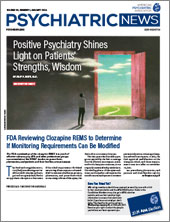Group IPSRT Feasible for Bipolar, Depressive Disorders
Interpersonal and social rhythm therapy (IPSRT)—which helps people to establish regular routines and social patterns—can be effectively delivered to a mixed group of patients with bipolar disorder or with major depressive disorder, a
report in
The American Journal of Psychotherapy suggests.
Researchers at Leiden University in the Netherlands recruited adult outpatients (aged 26 to 80) with either major depression or bipolar disorder to participate in 10 weeks of IPSRT. The therapy sessions were delivered twice weekly in groups of up to 12. The final sample included 38 people, of whom 27 were women (average age 65 years). Overall, IPSRT was well received, with the participants attending an average of 16.3 of the 20 sessions, and only nine (24%) dropping out prematurely. At the end of the program, 25 participants filled out a modified version of the Client Satisfaction Questionnaire (CSQ). The average CSQ score was 32.3 (max of 44), indicating good satisfaction, and almost all respondents were satisfied with the group composition.
The researchers did not identify any significant differences in mood symptoms or quality of life among the participants between the start and end of treatment. At the three-month follow-up assessment, however, the participants scored higher on quality-of-life measures than they had at baseline.
The researchers noted that the participants in the study had relatively low depression severity scores at baseline, which may explain why improvements were not detectable. “When participants are already in remission, longer follow-up periods are necessary to draw conclusions about the impact of an intervention on risk for recurrence of mood symptoms,” they wrote.
ADHD May Increase Risk of Rare Eye Disorder
Keratoconus is an eye disorder characterized by progressive thinning of the cornea, which can lead to double vision, blurred vision, and other problems. A
study appearing in
JAMA Ophthalmology reports that males with attention-deficit/hyperactivity disorder (ADHD) are at elevated risk of developing this condition.
Researchers at Tel Aviv University in Israel and colleagues examined 940,763 medical evaluations from Israeli citizens aged 16 to 45 who served in the military or were screened for service between 2011 and 2021. Keratoconus was documented in 1,533 of these individuals, or 0.16%.
The researchers found that ADHD was more common in individuals with keratoconus (15.9%) than in the general population (10.7%). Additional analysis revealed that males with ADHD had about a 62% increased risk of developing keratoconus, whereas there was no elevated risk in females with ADHD.
The researchers suggested that excessive eye-rubbing associated with ADHD—triggered by symptoms like poor sleep or learning frustrations—may contribute to progressive corneal damage.
Interestingly, they did not find that ADHD individuals with keratoconus had more severe ADHD symptoms than those without, nor did they find an elevated prevalence of this disorder among individuals with obsessive-compulsive disorder (OCD), severe anxiety, or autism. However, these conditions combined were present in just 1% of individuals with keratoconus, so the numbers were likely too small to make definitive associations. “While the study design provides hypotheses of associations for future investigations, cause and effect could not be ascribed directly,” the authors wrote. “Evaluating risk factors for keratoconus could generate hypotheses to be tested in future interventional trials.”
iCanQuit App Enhanced by Smoking Cessation Medications
Combining pharmacotherapy with use of a smartphone app for smoking cessation called iCanQuit may lead more people to quit smoking than use of the app alone, a
report in
Addiction has found. The findings are a follow-up analysis of data from a
clinical trial that compared iCanQuit with the National Cancer Institute’s QuitGuide app.
In the 2020 trial, investigators at the Fred Hutchinson Cancer Research Center in Seattle and colleagues found that both iCanQuit (which teaches users to accept smoking urges and strategies to let the urges pass) or QuitGuide (which focuses on preventing urges rather than accepting urges) were effective smoking cessation aids. However, iCanQuit was superior after 12 months, with 28% of users reporting being cigarette free for 30 days compared with 21% of QuitGuide users.
To be eligible for the trial, people could not be using nicotine replacement therapy or other smoking medications, such as varenicline; however, they could start using medications once the trial started. Of the 2,415 participants, 619 started using smoking cessation pharmacotherapy (mostly nicotine replacement) within the first three months. A total of 1,469 did not use pharmacotherapy throughout the 12-month study.
Overall, 34% of iCanQuit users who used any pharmacotherapy reported being cigarette free at 12 months, compared with 20% of QuitGuide users. Among those who specifically used nicotine replacement therapy, 40% of iCanQuit users reported being cigarette free at 12 months, compared with 18% of QuitGuide users. Among participants using no medications, 28% of iCanQuit users and 22% of QuitGuide users reported being cigarette free.
“The overall therapeutic message [of iCanQuit] is to use pharmacotherapy to manage triggers in the short term while they learn skills for accepting them in the longer term,” the investigators wrote. “This coherent blending of [acceptance and commitment therapy’s] specific behavioral skills with pharmacotherapy probably explains why the combination of pharmacotherapy with iCanQuit was more effective than iCanQuit alone.”
Delirium Increases Cognitive Risks for Long-Term Care Residents
Delirium appears to increase the risk of cognitive decline and death in older adults living in long-term care facilities, a
report in the
Journal of the American Geriatrics Society has found.
Researchers at the Ottawa Hospital Research Institute in Canada and colleagues examined retrospective data of all seniors aged 65 and older who resided in an Ontario long-term care facility and had at least one comprehensive medical assessment of their health, functioning, and cognition conducted between 2016 and 2018. The sample included 92,005 long-term care residents, of whom 2,816 (3.1%) met criteria for probable delirium during their assessment.
Residents who had probable delirium had about 50% increased odds of cognitive decline across the next 12 months compared with residents without delirium. Those with both probable delirium and dementia had the highest risk of cognitive decline, followed by residents with a dementia diagnosis without probable delirium, and then residents with probable delirium without a dementia. Residents with probable delirium were also more likely to die within the year of the assessment than those without delirium (52.5% versus 23.4%).
The researchers said that the poor baseline health and frailty of adults in long-term care may make them highly susceptible to delirium and its adverse short- and long-term effects.
“Considering that some episodes of delirium may be preventable, these findings underscore the need for delirium prevention strategies in long-term care,” they wrote.
Time of Light Exposure Found to Have Different Mental Health Impacts
Increased exposure to light at nighttime is associated with higher risk of psychiatric disorders, including depression, posttraumatic stress disorder (PTSD), psychosis, and self-harm, according to a
report in
Nature Mental Health.
Increased exposure to daylight, in contrast, is associated with a decreased risk of these problems.
“Avoiding light at night and seeking light during the day may be a simple and effective, nonpharmacological means of broadly improving mental health,” wrote the study investigators. The study was conducted by a team at Monash University in Melbourne, Australia, and colleagues.
The investigators made use of a UK Biobank project in 2013 in which over 100,000 participants of this ongoing biomedical registry wore a special watch to measure movement, sleep, and light exposure across one week. Of this group, 86,631 participants had sufficient day and night data for analysis. The participants were then divided into quartiles based on their amount of daylight or nightlight exposure, in lux (lumens per square meter).
The investigators found that increased exposure to daylight or nightlight had opposite effects on psychiatric disorder risk. For example, individuals in the brightest nightlight quartile had about a 30% higher risk of depression and self-harm compared with the lowest quartile. Individuals in the brightest daylight quartile had about a 20% lower risk of depression and self-harm compared with the lowest quartile.
“Remarkably, these associations were independent and additive. For example, greater night-time light exposure was associated with increased odds of [major depression] even for those in the brightest daytime light quartile,” the investigators wrote. “These associations were also independent of demographic, physical activity, photoperiod [daylight hours], and employment covariates.” ■





